The First Comic Book Magazines
The first comic book appeared in 1933
Famous Funnies was a collection of comic strips printed together in one magazine.
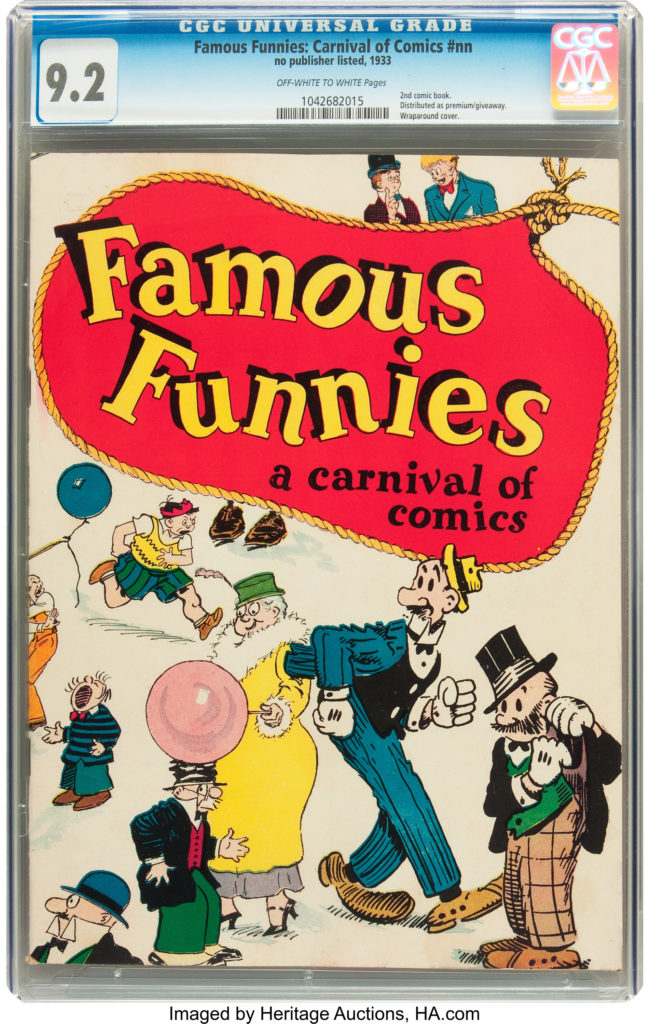 However, the first comic magazine to feature all original material was published by DC comics in 1935.
However, the first comic magazine to feature all original material was published by DC comics in 1935.
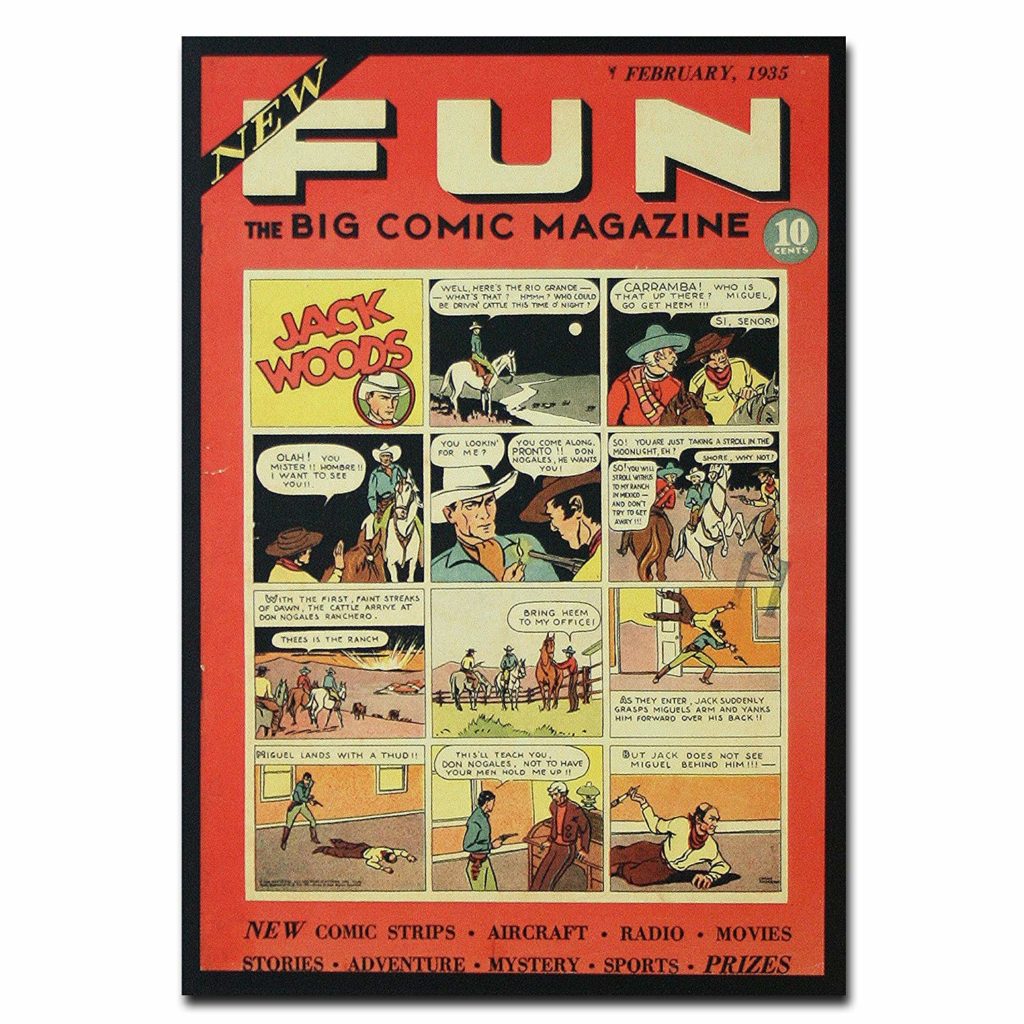 It was an anthology comic.
It was an anthology comic.
Detective Comics No 1 appeared in 1937. It is the longest running comic book title (still being published today), and we’ll come back to discuss it many times. DC comics derives their name from this book.
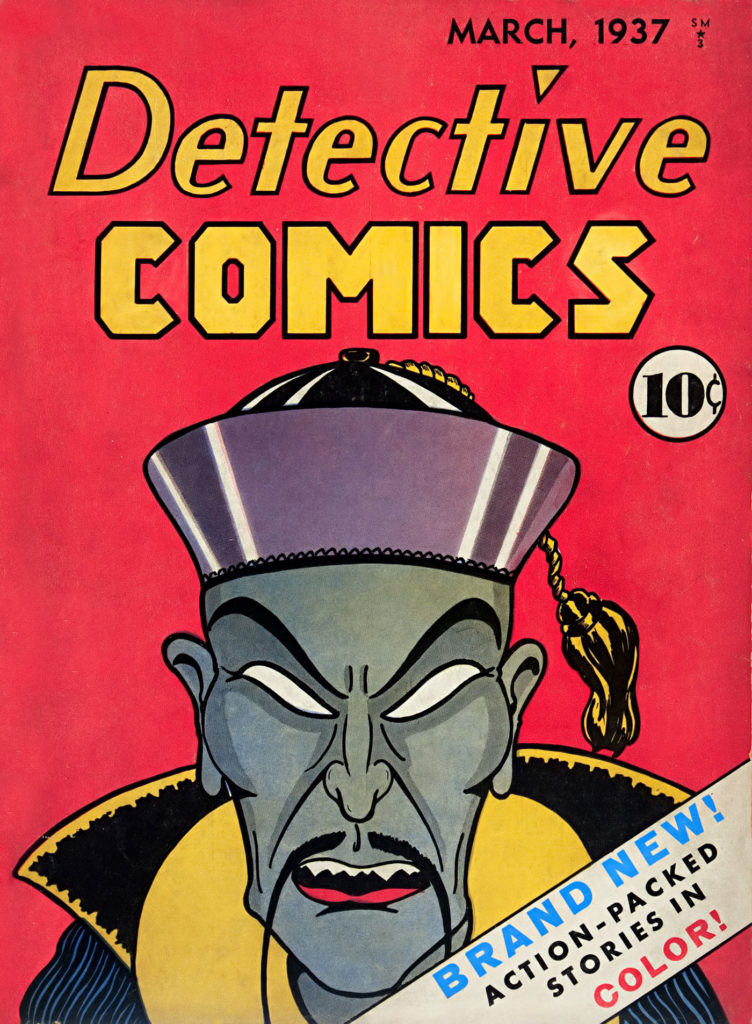
Superman
The “Golden Age” of Comics officially begins with Action Comics no 1 also published by DC.
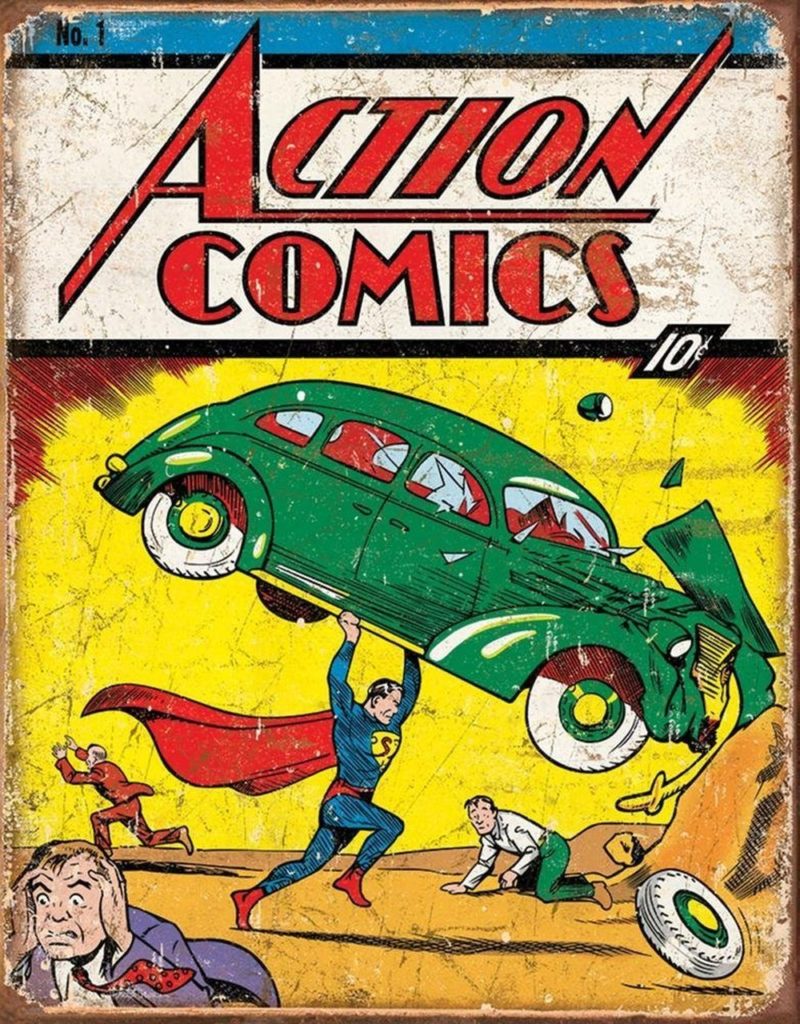
There is a lot to say about Superman. Much of it has already been said. Here are what I believe to be the key points:
- Superman is essentially a “Moses Myth” created by a couple Jewish kids from Cleveland. One of whom lost his father in a burglary. We can imagine why he imagined a bullet proof hero.
- At the time the pulps and the adventure comic strips were very popular. It isn’t hard to understand why this would have caught on with young male readers.
- Superman was originally envisioned as a villain, but the design for that version eventually became the basis of design for Lex Luthor.
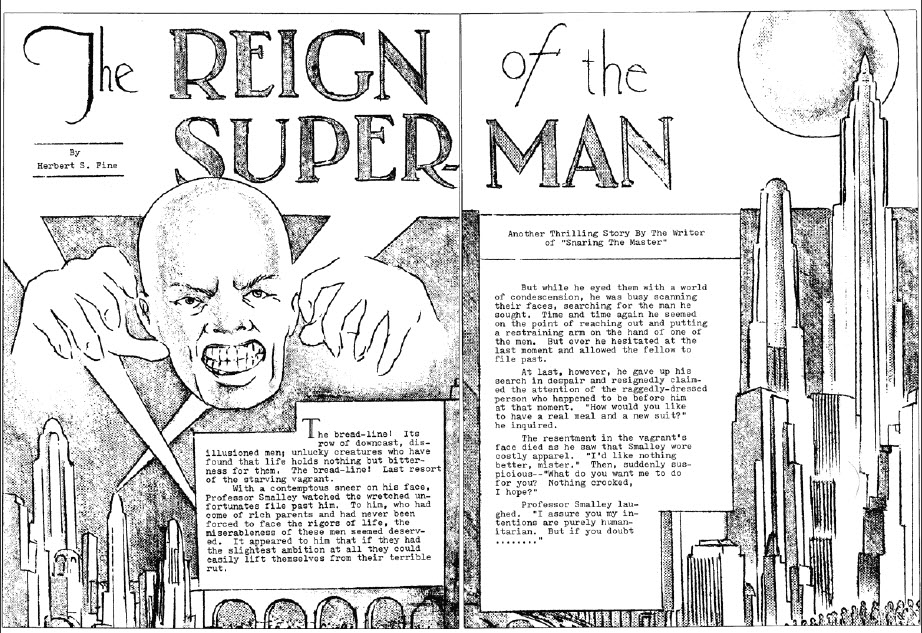
- “A couple of months after I published this story, it occurred to me that a Superman as a hero rather than a villain might make a great comic strip character in the vein of Tarzan, only more super and sensational than that great character. Joe and I drew it up as a comic book – this was in early 1933. We interested a publisher in putting it out, but then he changed his mind, and that was the end of that particular version of Superman – called The Superman. Practically all of it was torn up, by the way. Joe got very upset and tore up and threw away most of it.” – Jerry Siegel
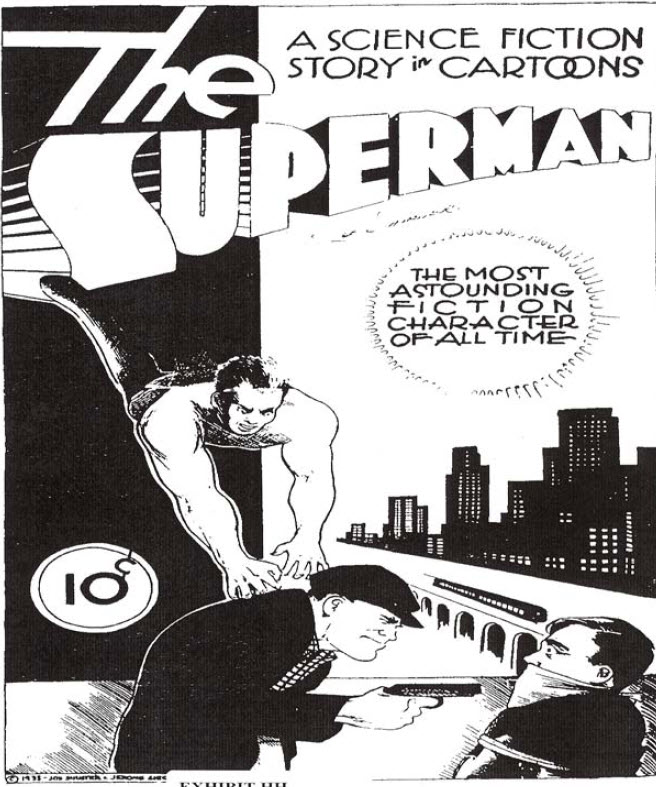
- “We saved the cover. The rest of the drawings were a crude version of Superman. It wasn’t really Superman: that was before he evolved into a costumed figure. He was simply wearing a T-shirt and pants; he was more like Slam Bradley than anything else – just a man of action. But we called him The Superman. That was the second time we used the name, but the first time it was used for a character of goodwill. I’m a perfectionist, and I think the fact that the drawings had been turned down made me want to tear them up. I simply destroyed them. I said, ‘If we ever do it again, I’m going to redo it properly.’ It was a very low period for us.” – Joe Shuster
- “Siegel and Shuster earned fairly high salaries writing and illustrating Superman comics. But they received no royalties. They signed away all rights to their character for $130. “Our company has very little to gain in a monetary sense from the syndication of this material,” DC Comics’ publisher disingenuously told Siegel in 1938 in response to one of his many requests for more cash. “Also bear in mind … that we can at any time replace you.” Siegel and Shuster were then fired in 1947 after filing a lawsuit against DC. A financially struggling Siegel returned to the company in 1959, accepting standard pay and no byline. He left again in 1965 and lodged a second, equally unsuccessful suit that dragged on for years. When a Superman movie began production in the 1970s, Siegel put a curse on it as part of a public relations campaign. The shaming strategy worked, as DC’s parent company agreed to give him and Shuster pensions of $20,000 a year, a sum that later went up. Furthermore, DC once more began crediting them as Superman’s creators. Following their deaths in the 1990s, Siegel’s and Shuster’s heirs brought additional copyright litigation that remains ongoing.” – JESSE GREENSPAN
- Jesse Greenspan brings up an interesting point here, but he neglects to mention the large role several artists had in helping Siegle and Shuster with their case in the 1970s, most notably: Neil Adams, who we’ll discuss later.
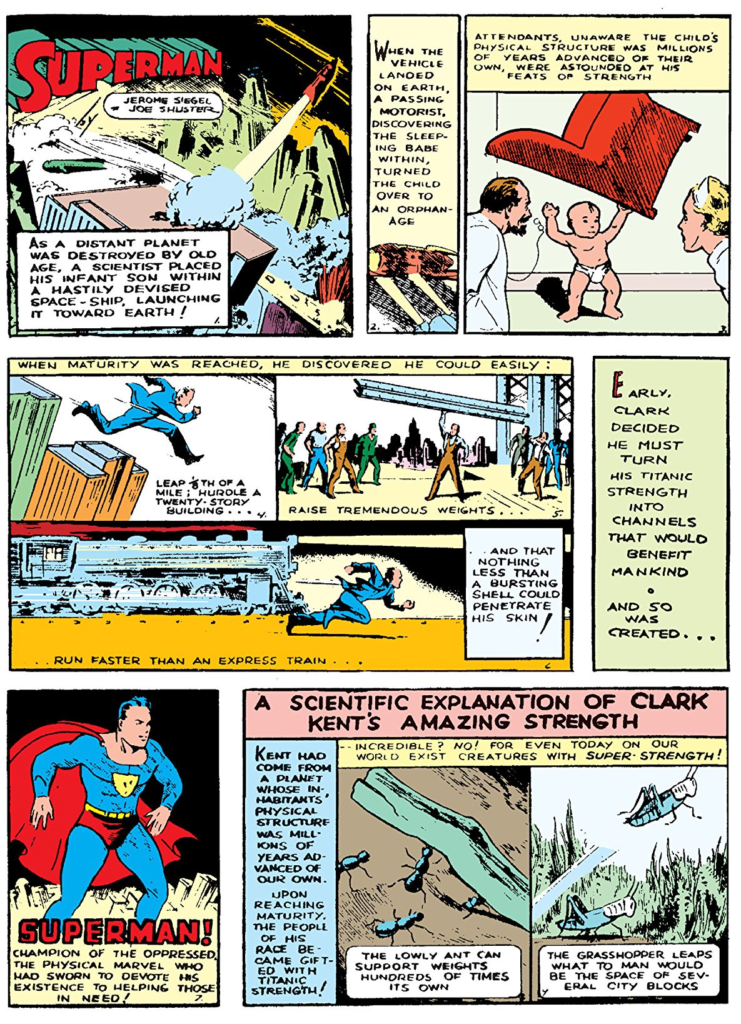
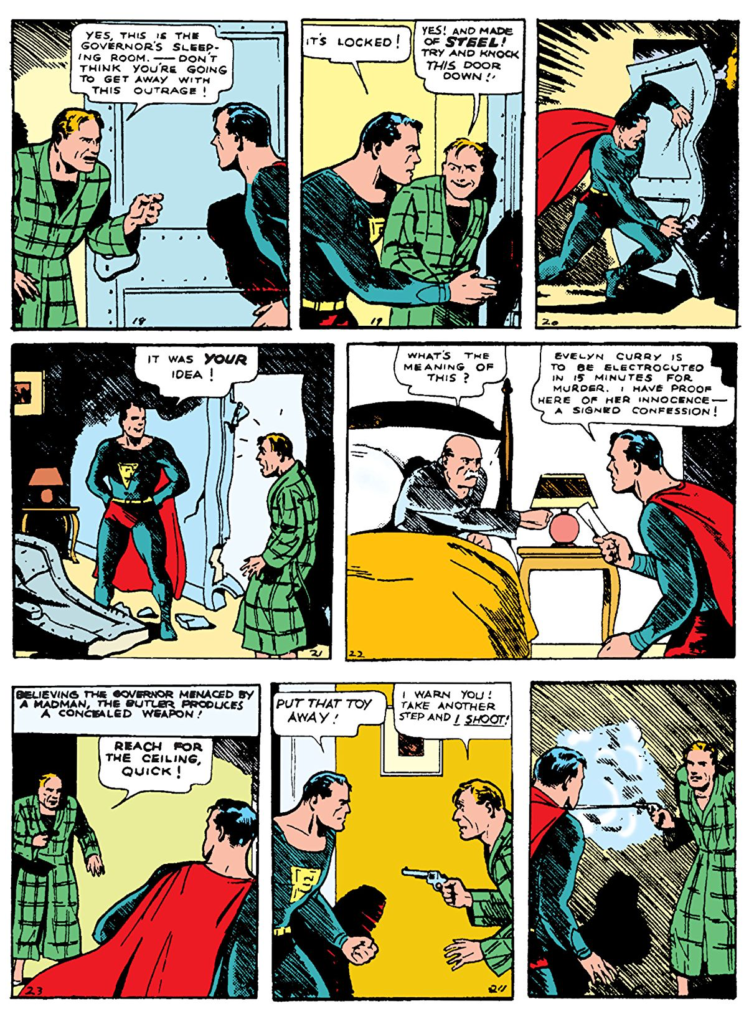
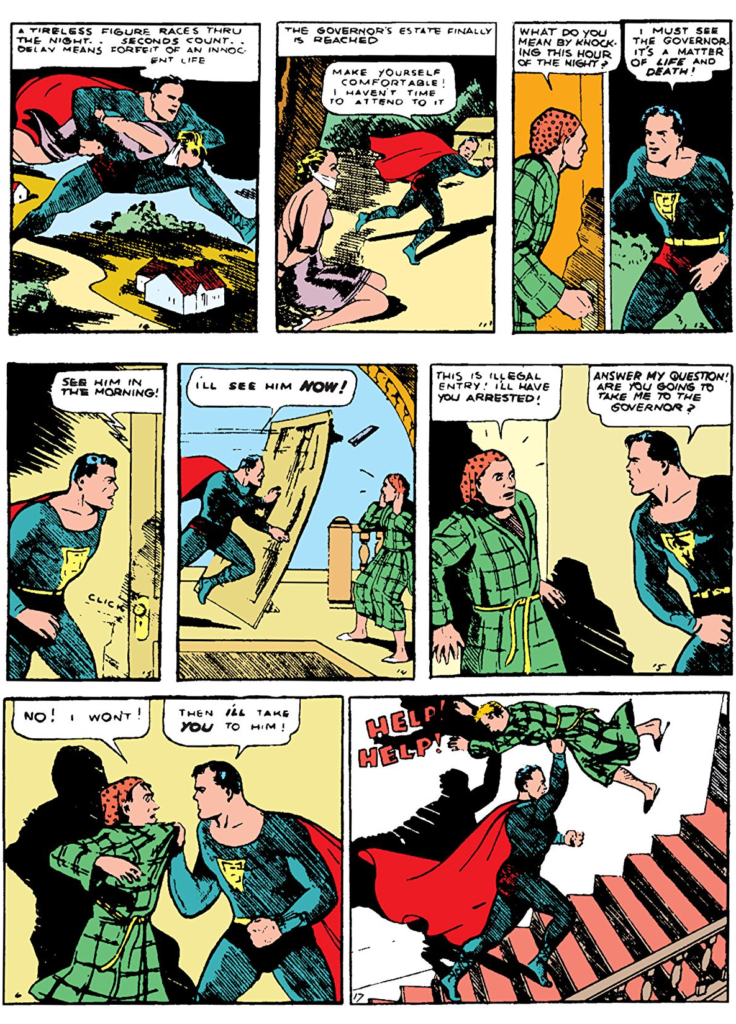
Batman
A few months after Action Comics No 1 Detective Comics No 27 was published featuring the first appearance of Batman
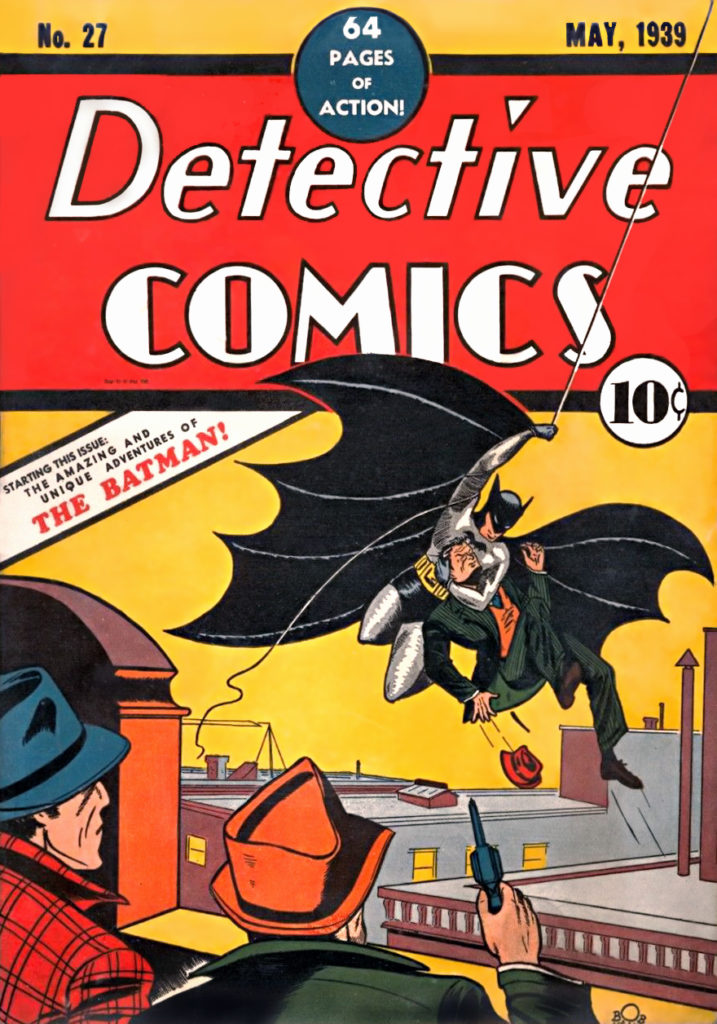
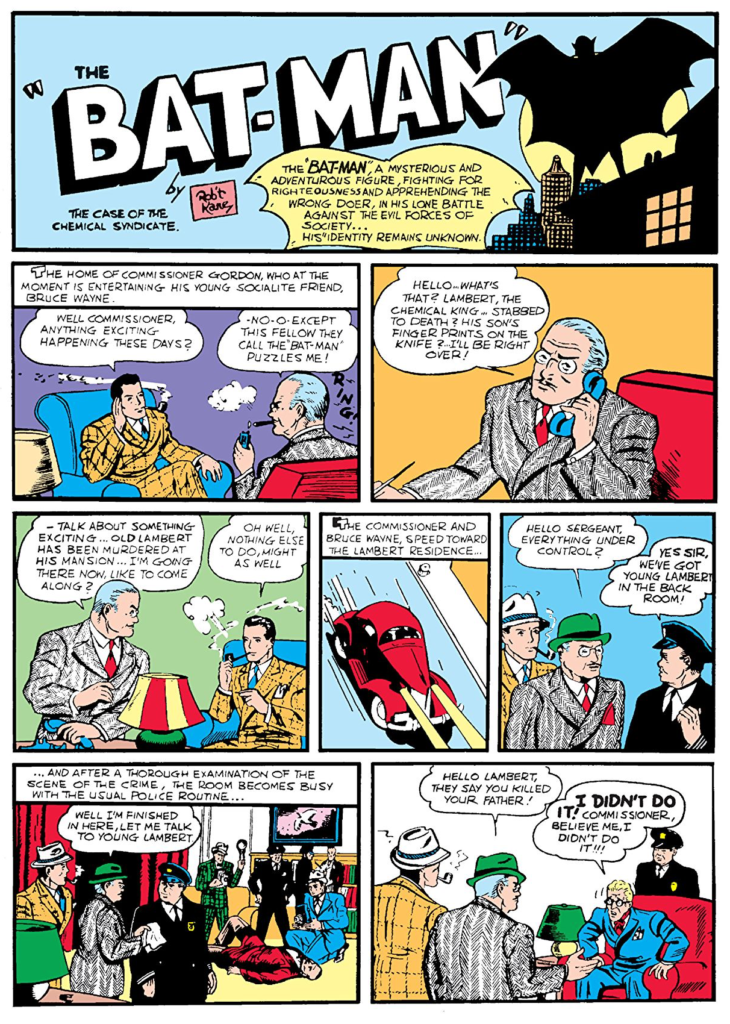
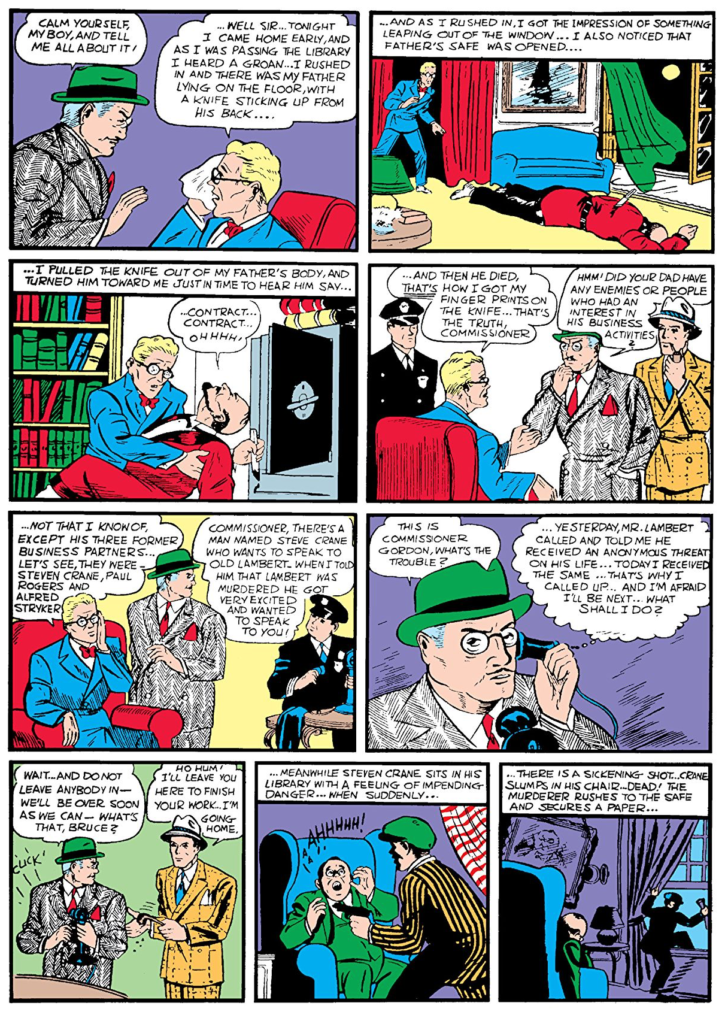
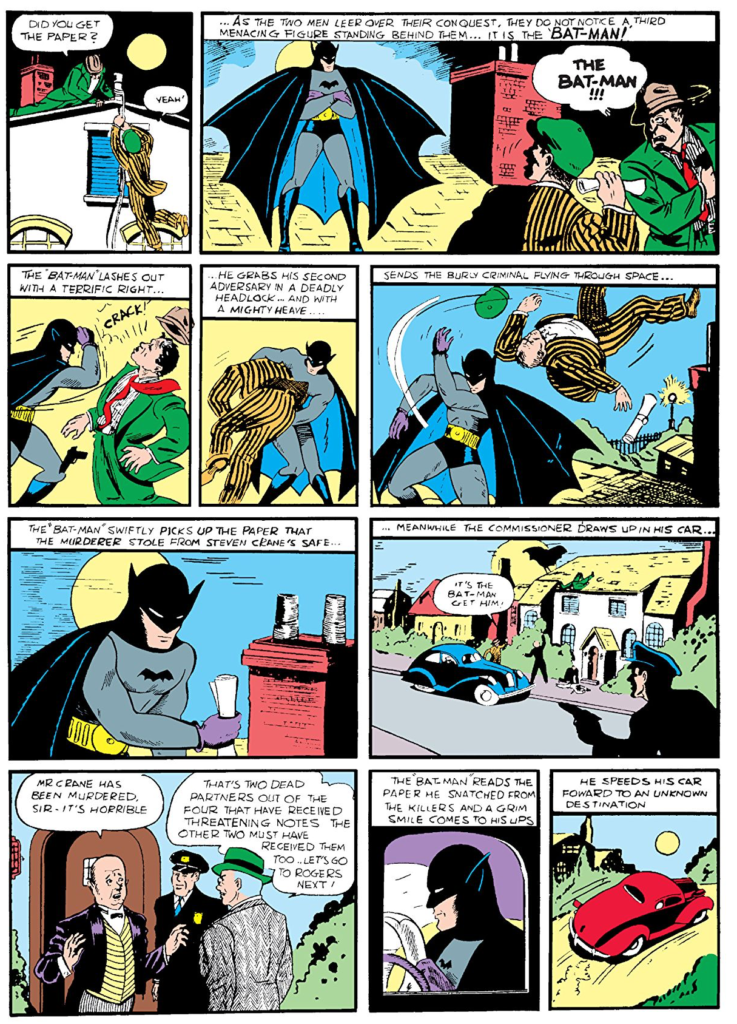
Legally, Bob Kane created Batman. the controversy surrounding this is that his collaborator, Bill Finger was probably more responsible for Batman’s success.
“After Superman debuted in 1938 and became an instant hit, DC editor Vince Sullivan asked Bob Kane to come up with a superhero, which he did with Batman…During that process, he went to a friend, Bill Finger, who gave him some tips on costume adjustments. For example, Bob initially drew bat wings on Batman. Bill suggested a scalloped cape. After Batman became a hit in May, 1939, Bob brought in more people throughout the year.
Bill was an amazing writer, who wrote for Batman for more than 30 years and came up with a lot of great stories, but so did others. Gardner Fox wrote a lot of the stories that inspired the TV series in 1966. Christopher Nolan credits Batman editor Denny O’Neil and writer Alan Moore with influencing him in Batman Begins. Kane, Finger, and Kane’s art assistant, Jerry Robinson, all claimed to have collectively come up with the Joker and Robin…both Finger and Fox laid claim to origin story, which appeared in Detective Comics #33 in November, 1939,” he adds. “We credit Gardner Fox, but I do know that some folks have given credit to Bill Finger over the years, so I guess it’s one of those stories where no one knows for sure.” -Steve Korté
I don’t pretend to be an expert about the origin of Batman, but I have read things to suggest that Kane was pretty well-off, and his father secured a good lawyer for him, so he nailed down the copyright for Batman with the DC comics editors before getting started. As I understand it, the name, the idea he was a detective, and the idea that he was a millionaire masquerading as Batman. This means Kane was riffing on a popular pulp character of the day called “The Shadow”. The difference was that Batman would be a comic book character who looked like a Bat. All the additional concepts, the outfit, the gadgets, the car, the butler, the Joker, etc. are believed to have come from Bill Finger.
The Origins of Marvel Comics
The same month Batman appeared, another “Super Hero” appeared in a comic magazine called “Motion Pictures Funnies Weekly” No 1. The character in that magazine was called “The Sub Mariner” and he was to become the first Marvel super hero, though Marvel didn’t have that publishing name yet. They were about to become known as “Timely Comics” What differentiated the Sub Mariner was that he was an anti-hero.
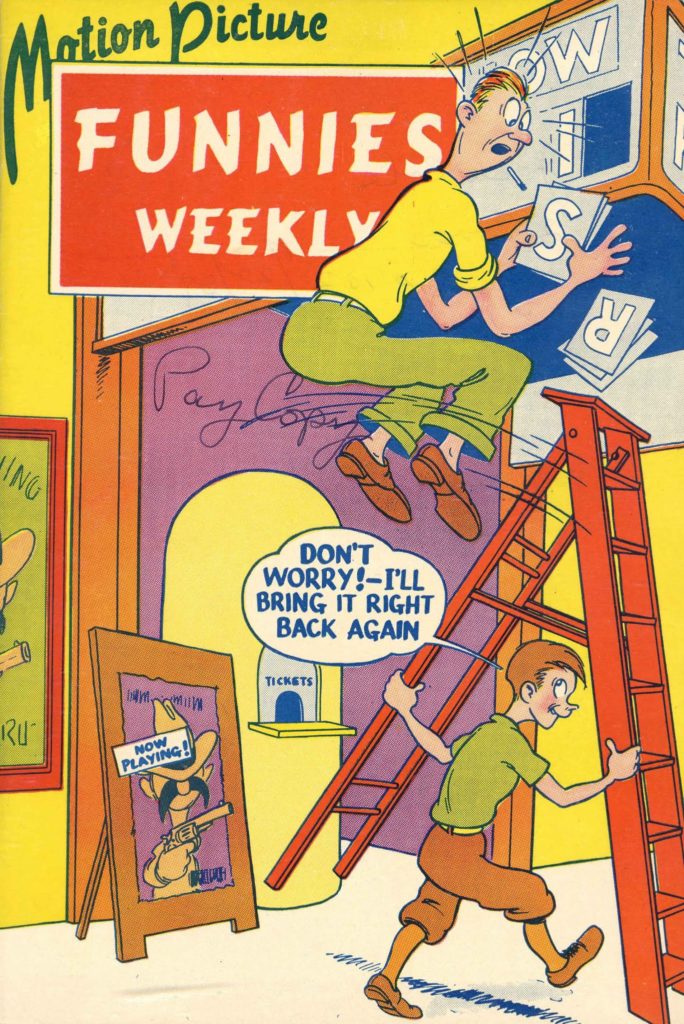
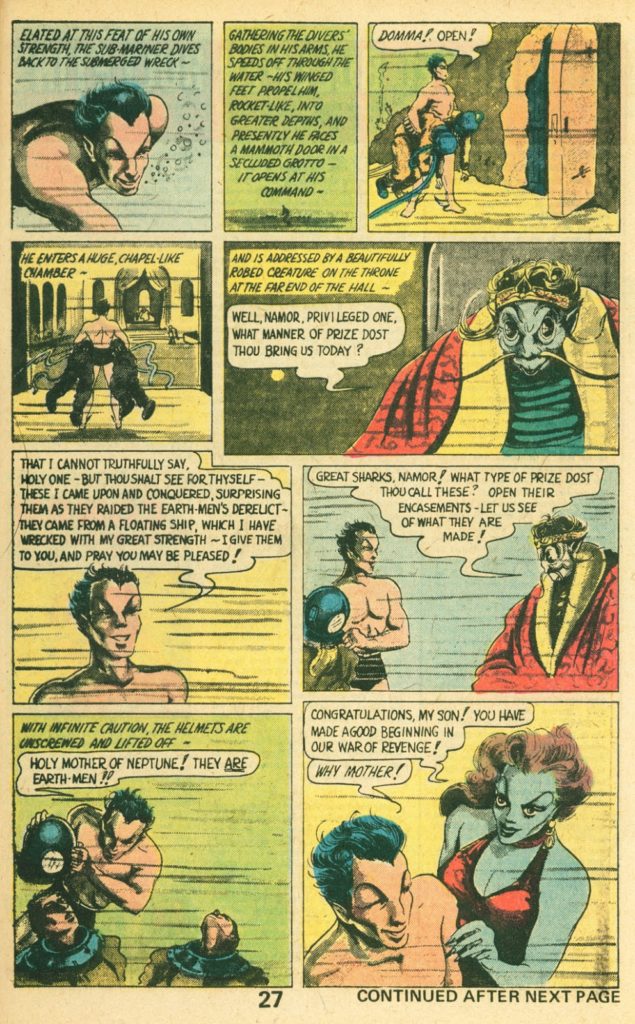
November of 1939 Timely introduced its second character. A flaming android called the Human Torch.
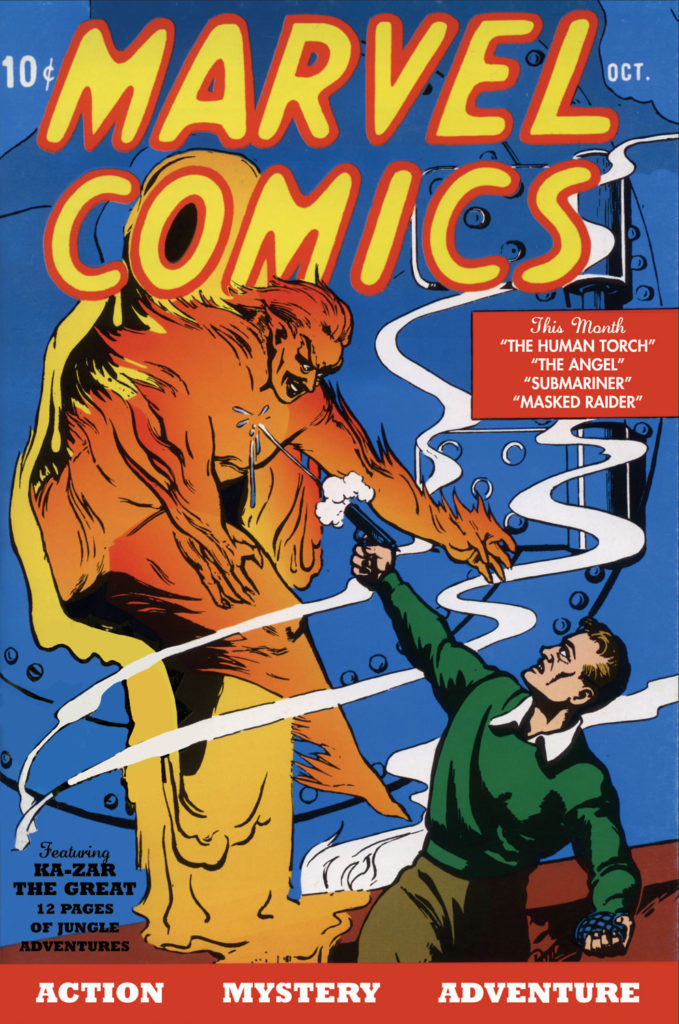
In 1940 the original Flash appeared in an All Star comics publication called “Flash Comics”, All Star Comics would eventually merge with DC.
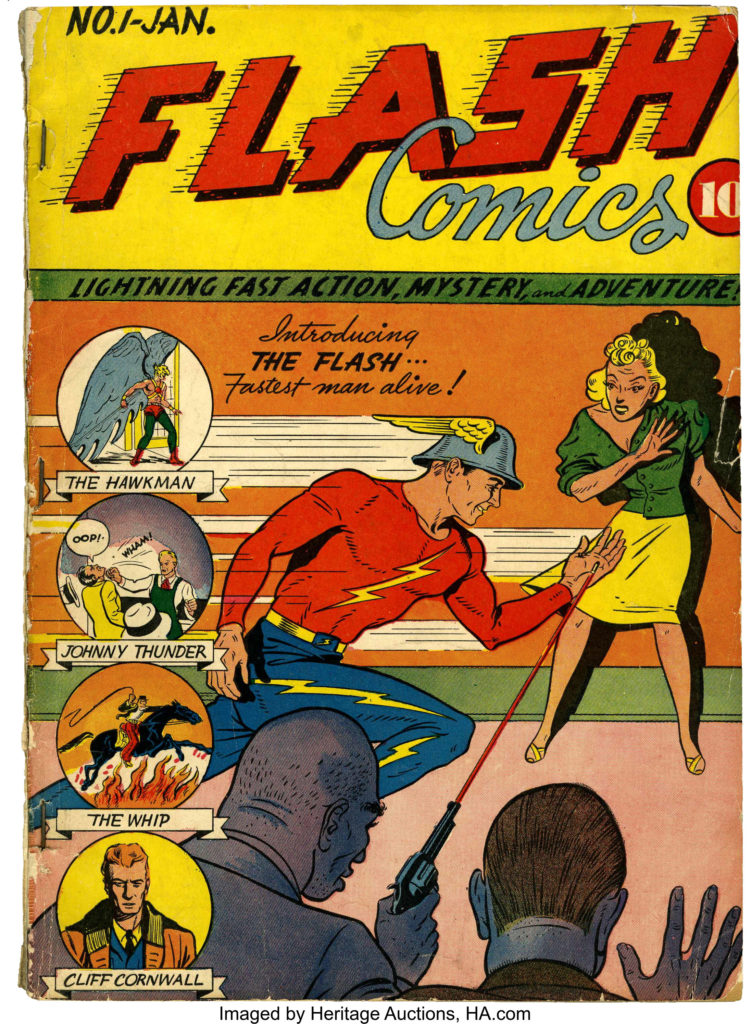
The Flash was the creation of writer Gardner Fox and artist Harry Lampert.
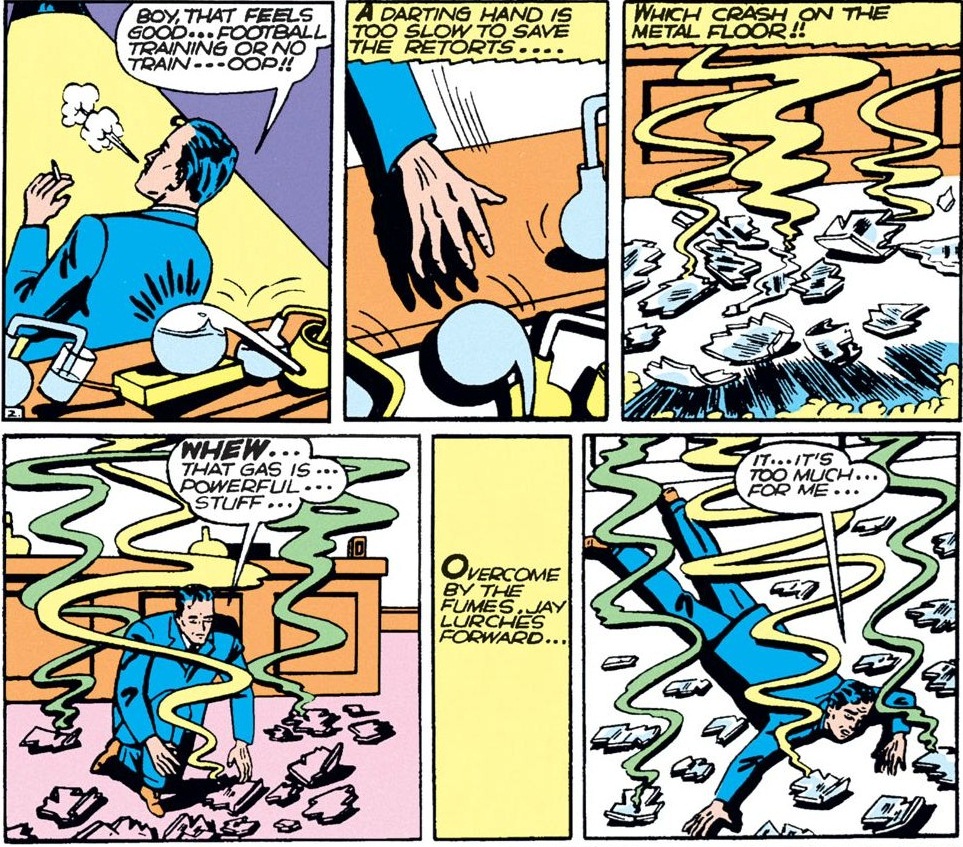
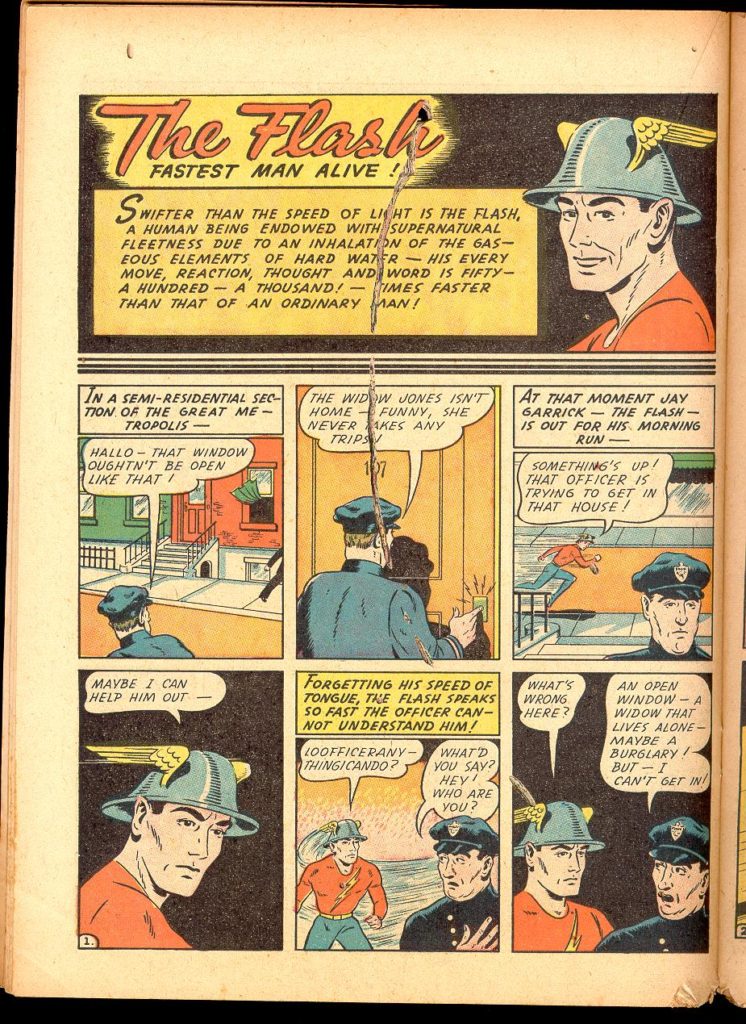
The following month Captan Marvel made his debut in Whiz Comics, published by Fawcett Comics. Written by Bill Parker, and drawn by C.C. Beck. The original name for Captain Marvel was going to be Captain Thunder, but Fawcett’s general manager suggested the change. The original idea was to create a group of characters that all had one special ability, but that idea was rejected. So he created one character with all the special abilities he’d envisioned: Solomon’s wisdom, Hercules’ strength, Atlas’ stamina, Zeus’ power, Achilles’ courage, and Mercury’s speed.
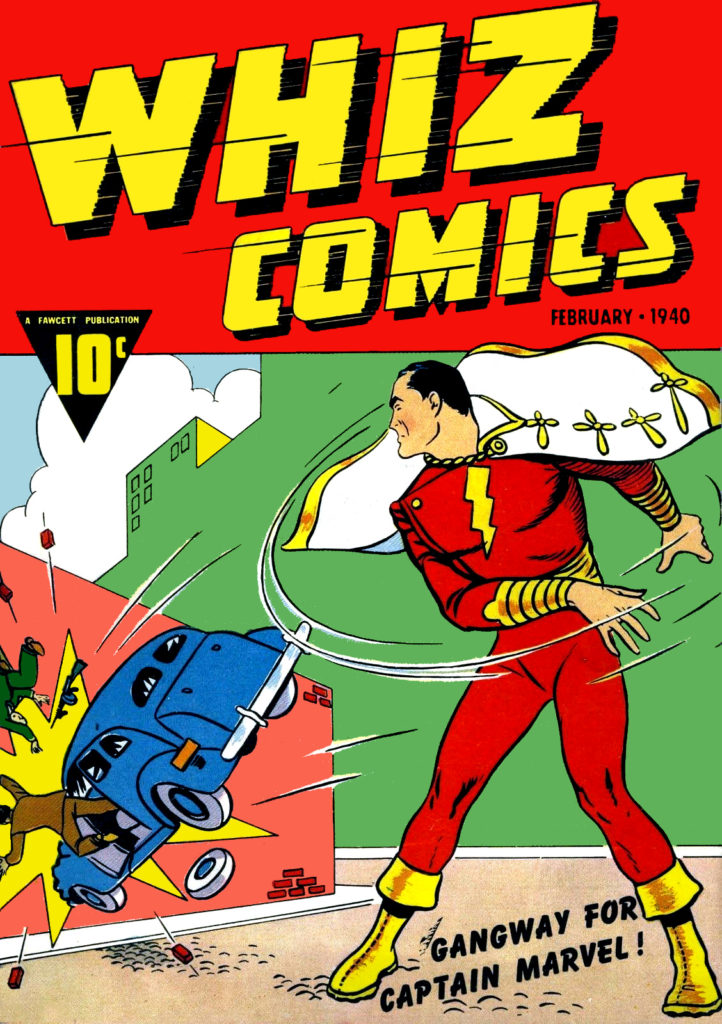
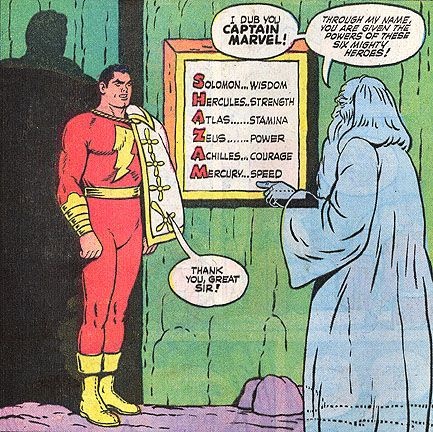
Captain Marvel and the Marvel family were incredibly popular, outselling Superman. DC later sued Fawcett claiming that Captain Marvel was too similar to Superman, and they won!
“The studio behind the film Republic Pictures was originally working with DC, or National Comics Publications at the time, to make a “Superman” picture, but they already had an existing cartoon deal with Paramount Pictures, which prohibited them from signing another. So Republic Pictures chose “Captain Marvel” instead. DC was obviously not pleased. Fawcett had already published “Master Man,” an obvious copy of “Superman” that they stopped publishing after DC had threatened with lawsuit. They believed “Captain Marvel” was just another imitation as well.
In June 1941, National Comics finally sued Fawcett for copyright infringement. This began National Comics Publications versus Fawcett Publications, one of the longest-running legal battles in the history of comic books, lasting over 12 years. Here’s what happened.
DC’s argument was simple, that Captain Marvel’s main powers and characteristics were too similar to Superman and therefore infringed on its copyright. Fawcett argued that although these two characters were similar, it wasn’t to the point of infringement and that similar feats have already been performed by other fictional characters like Popeye or Tarzan.
To prove their point, National Comics prepared a binder over 150 pages in length with panels from their comics of “Superman” juxtaposed with similar panels of “Captain Marvel.” Everything was in close scrutiny, from their costumes, boots, capes, the ability to leap great distances, the ability to fly, extraordinary strength and speed, invincibility to bullets, shells, explosives, and their secret identity. They went as far as to include that they both had clean-cut faces.
The verdict was clear, the judge eventually ruled that “Captain Marvel” was indeed a copy of “Superman,” but it was Fawcett who won the trial. It was all because of one tiny mistake, a mistake that looked like this. This was the copyright symbol used back in the 1950s. The lawyers from Fawcett discovered that McClure Syndicate, the newspaper company that published the “Superman” comics, had forgotten to place these symbols on several of their strips and argued that DC had no copyright to “Superman,” and the court agreed.
This was devastating news for DC. It meant that it did not own Superman and that anyone could publish Superman’s stories without legal repercussions. This lasted over two years. Out of 160 strips of “Superman,” published from January 1939 to April 1950, less than half of them were from Detective Comics.
DC immediately appealed, and despite the damage, the decision was reversed. The judge of the case, Learned Hand, declared “Captain Marvel” a deliberate and unabashed duplicate of “Superman” and told Fawcett to cease all of its publications and pay DC for the damage it owes. Fawcett settled.
By 1950, the Golden Age of Comic Books had come to an end. Sales were slumping to all-time lows, and Fawcett simply decided that it wasn’t worth fighting. They paid $400,000 in damages, almost $4 million by today’s standards, and with its last issue, it seemed like the end for “Captain Marvel.” As you well know, it was not.” – Nathaniel Lee.
A story for later on, but Fawcett reimagined Captain Marvel in the 50s as a character called “MarvelMan”, published later in America as “Miracle Man”, and that is an incredibly fascinating comic, as well as a fascinating story about publishing rights. We’ll discuss it at length when we get to the 90s.
Last thought about Captain Marvel: those comics created the action/comedy model that is the most popular tone for Super Hero properties to this day. It created the idea of the boy super hero, later utilized by Spider Man, and the Teen Titans, and it created the family of super heroes with their own magazines. Mary Marvel and Captain Marvel Jr were both popular enough to get their own books. Elvis famously based his rhinestone outfits on the look of Captain Marvel Jr.
Robin
In April of 1940 Robin debuted in Detective Comics #38. He was the first of the kid sidekicks. Created by Bob Kane, Bill Finger , and Jerry Robinson.

His look was inspired by the concept for the look of “Robin Hood” that was popular at the time. Here’s an illustration of Robin Hood by NC Wyeth
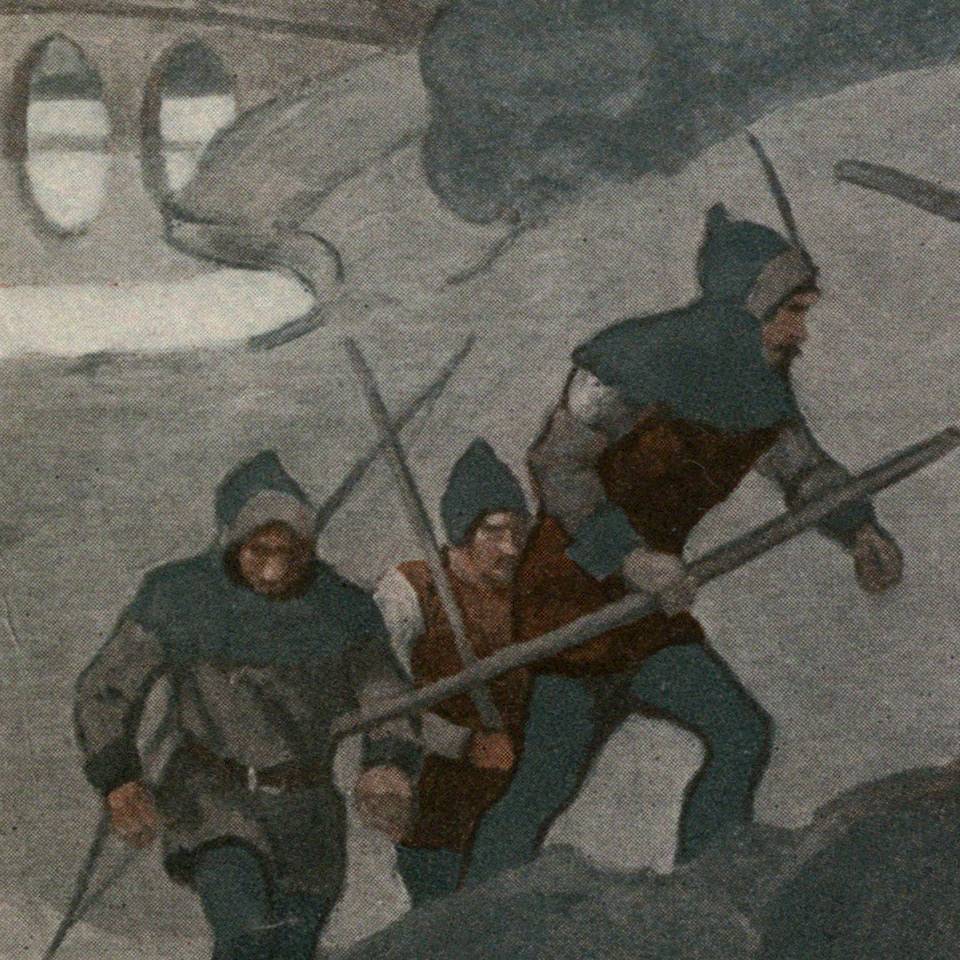
“Robin was an outgrowth of a conversation I had with Bob. As I said, Batman was a combination of Douglas Fairbanks and Sherlock Holmes. Holmes had his Watson. The thing that bothered me was that Batman didn’t have anyone to talk to, and it got a little tiresome always having him thinking. I found that as I went along Batman needed a Watson to talk to. That’s how Robin came to be. Bob called me over and said he was going to put a boy in the strip to identify with Batman. I thought it was a great idea.” – Bill Finger
Green Lantern
Published in All Star Comics no 16 (All Star Comics would later merge with DC), Martin Nodell created Green Lantern, a man with a magic ring, that could create and/or effect anything he imagined, but could not effect wood. He had to charge the ring every 24 hours by touching it to a battery shaped like a lantern.
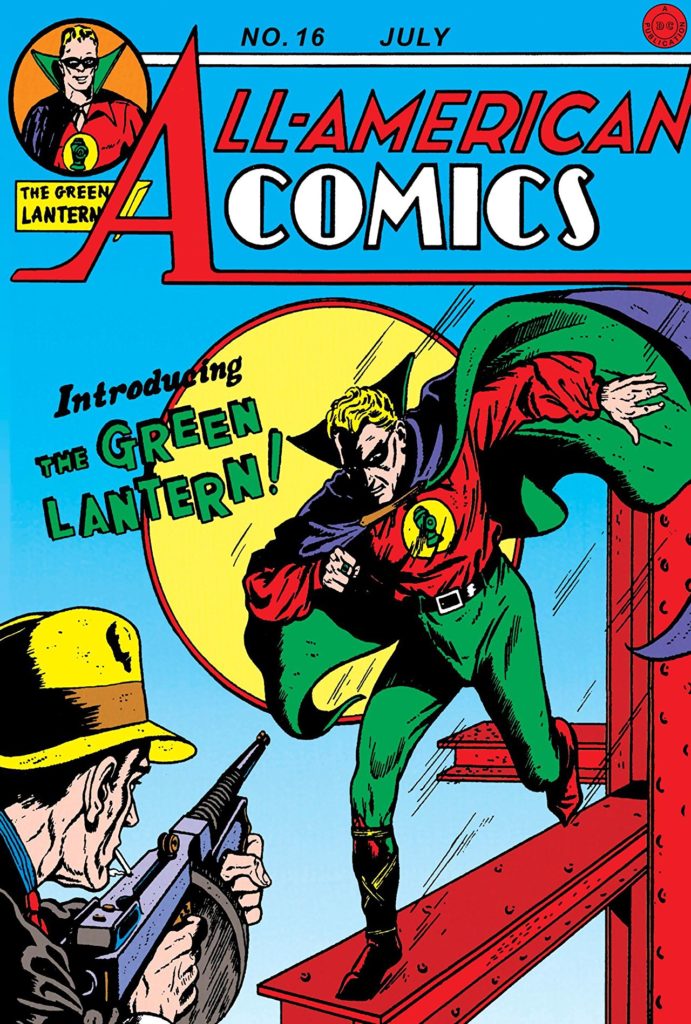
Captain America
Captain America was pretty popular for a very short time in the 1940s, created by Joe Simon and Jack Kirby. We’ll talk about Jack a LOT in the 60s, 70s, and early 80s. Not the first, but the most popular of all the patriotic heroes that emerged at this time. Captain America would become more significant when revitalized by Kirby and Stan Lee in the 1960s, but even in the 40s he does demonstrate the popular conception of a comic book hero of the day: strong man dressed in bright colors with a teenage sidekick.
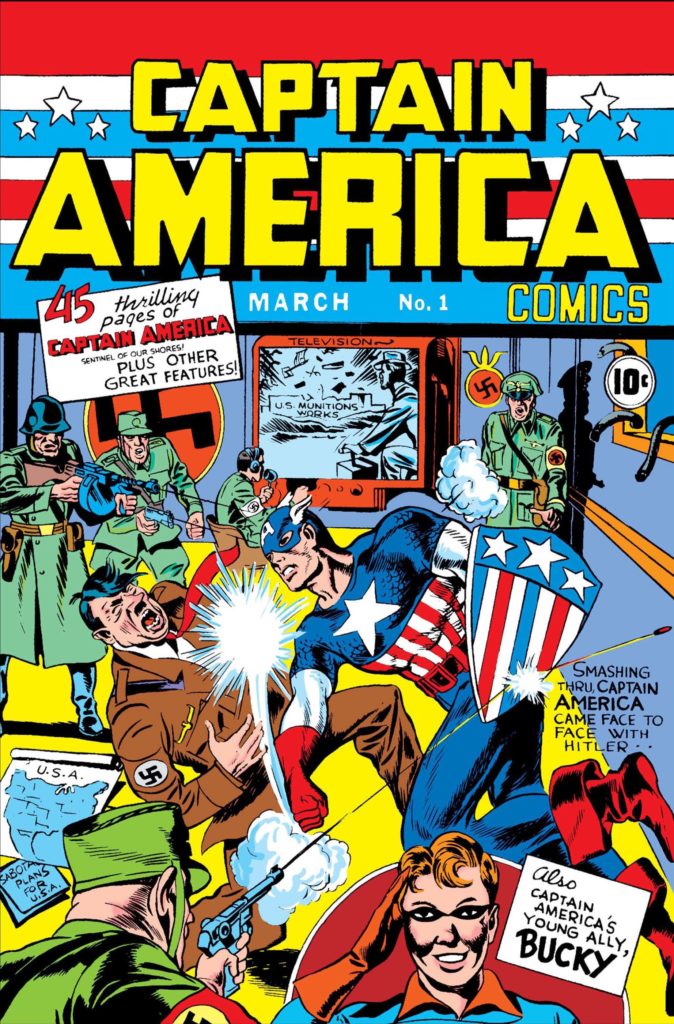
Super Hero Team Up
A way in which Timely comics were changing the game of super hero comics in the 40s was by introducing the idea of the super hero team up that begins with a battle between heroes. The first time characters from different books appeared together in one book was Marvel Comics no 9.
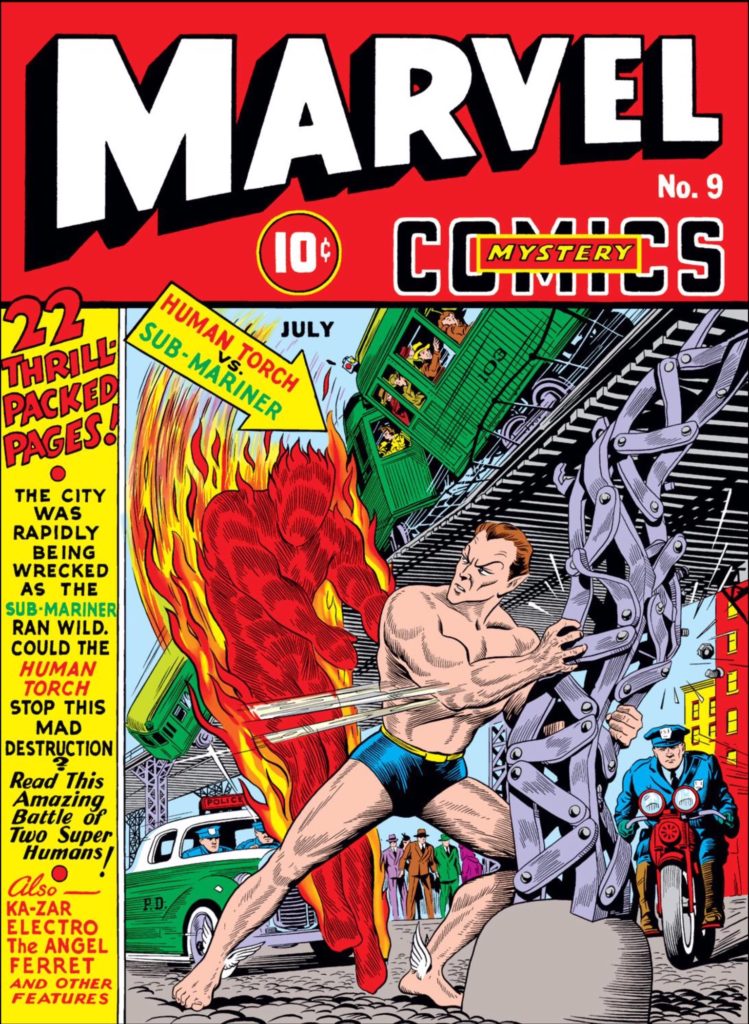
Later that year, All Star Comics developed the idea by introducing the Justice Society of America. The first Super Hero Team.
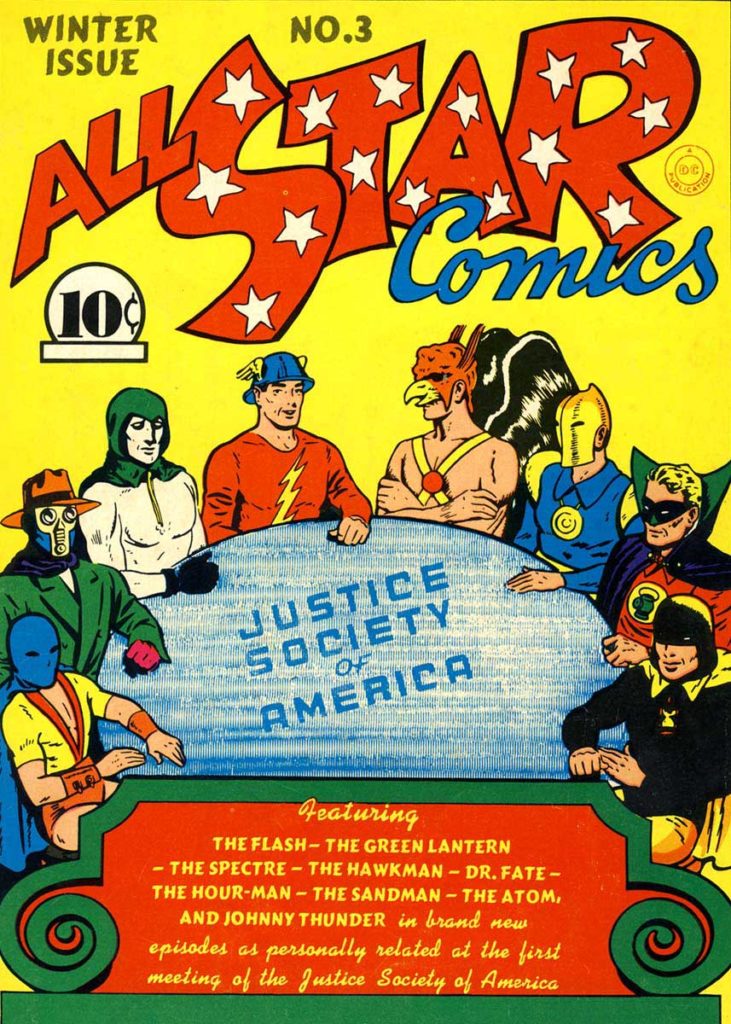
Briefly, the characters shown here from left to right are:
The Atom: a short guy who was a great boxer.
The Sandman: a crimefighter with a gas gun.
The Specter: another Jerry Siegle (of Superman fame) creation, the specter is a cop who died, and was brought back by the literal spirit of vengeance from the Bible. He avenges those who are wronged in godly ways.
The Flash: who we already mentioned.
Hawkman: Carter Hall is the reincarnation of Egyptian prince Khufu who discovered the ninth metal (later changed to nth metal) with gravity defying properties that allowed him to fly. As an archeologist, he used ancient weapons from the museum he curated.
Dr Fate: Without the helmet, Kent Nelson is an ordinary guy. With the helmet, he is possessed by the Egyptian sorcerer Nabu.
Green Lantern: we’ve already discussed.
HourMan: Rex Tyler, chemist, developed a pill that can give him great strength for an hour.
Wonder Woman
Though Fantomah was the first female super hero with powers to appear in a comic book, Wonder Woman Created in 1942 by William Moulton Marsden and H.G. Peter was the first popular female super hero.
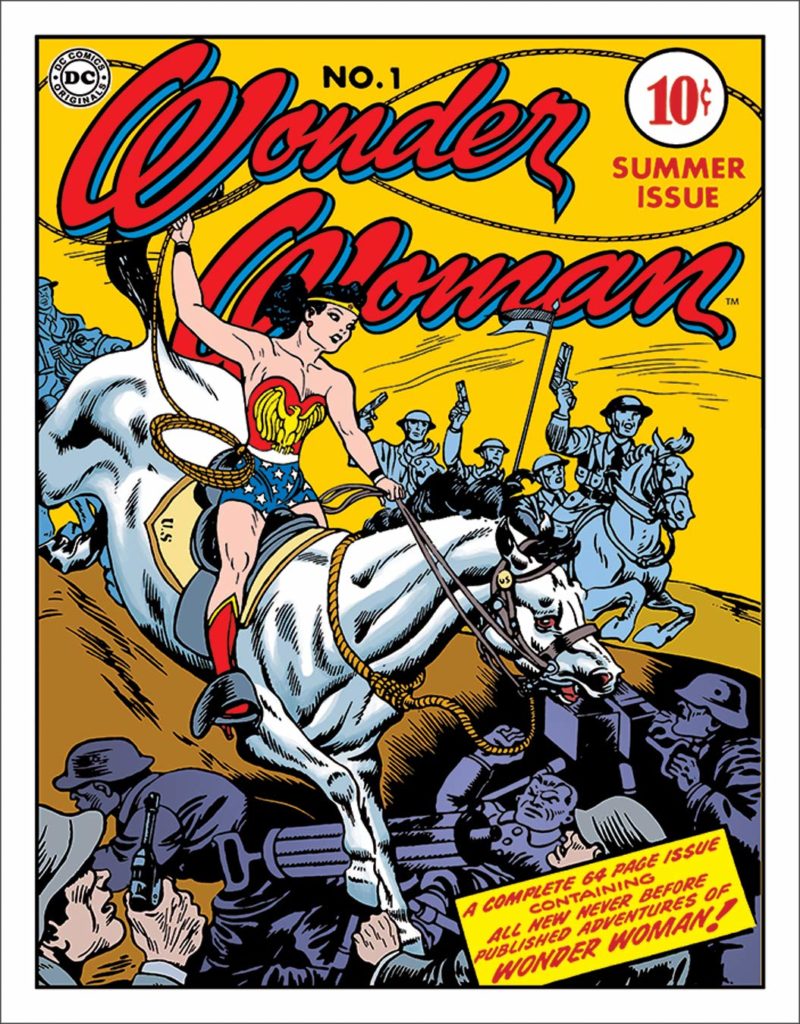
There is a lot to say about Wonder Woman, but I’ll try to condense it to the important points.
- Marsden was famous for having invented the technology that led to the invention of the polygraph. In an interview he mentioned his feelings that the comic book medium could go further.
- Max Gaines, a published at All American Comics, read the interview and immediately contacted Marsden to discuss his creating a comic book character.
- Marsden and his wife discussed the idea and felt the character should be a woman.
- “Not even girls want to be girls so long as our feminine archetype lacks force, strength, and power. Not wanting to be girls, they don’t want to be tender, submissive, peace-loving as good women are. Women’s strong qualities have become despised because of their weakness. The obvious remedy is to create a feminine character with all the strength of Superman plus all the allure of a good and beautiful woman.” — William Moulton Marston
- This is where it gets tricky. Marsden was a swinger who was into bondage. He and his wife had a woman who lived with them named Olive Byrne, and it’s pretty well documented that the three of them coexisted in all the ways you think I’m implying.
- Wonder Woman, as conceived by Marsden, was an amazon (to connect her to mythology), but he gave her 2 tools I want to mention first: a lasso of truth (whenever she puts it around someone they are compelled to tell the truth) and bullet proof bracelets. However, while the bracelets give her the power to deflect bullets they also rob her of her power if they are bound by a man. I think the metaphor is clear when you see this photo featuring Marsden’s wife hooked up to a lie detector, and Olivia taking notes as she wears he bracelets that were likely used for other activities behind closed doors.
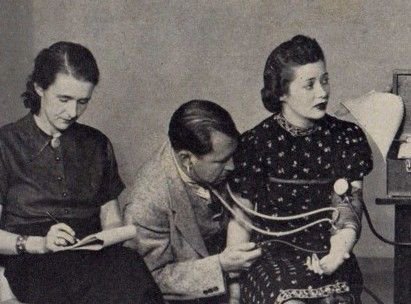
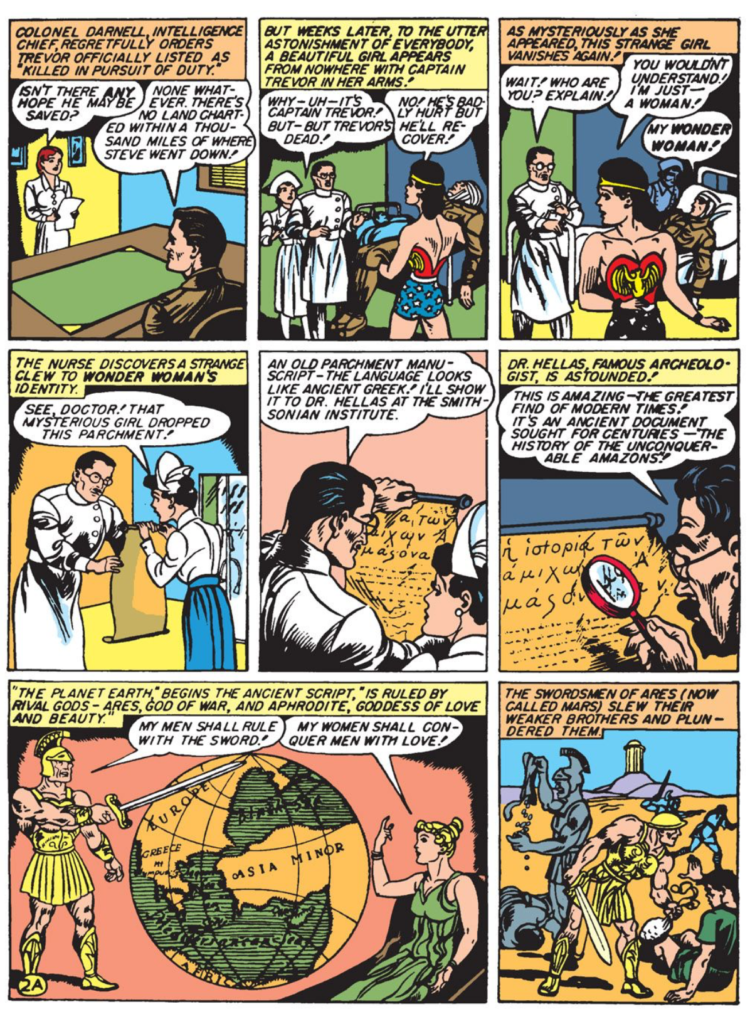
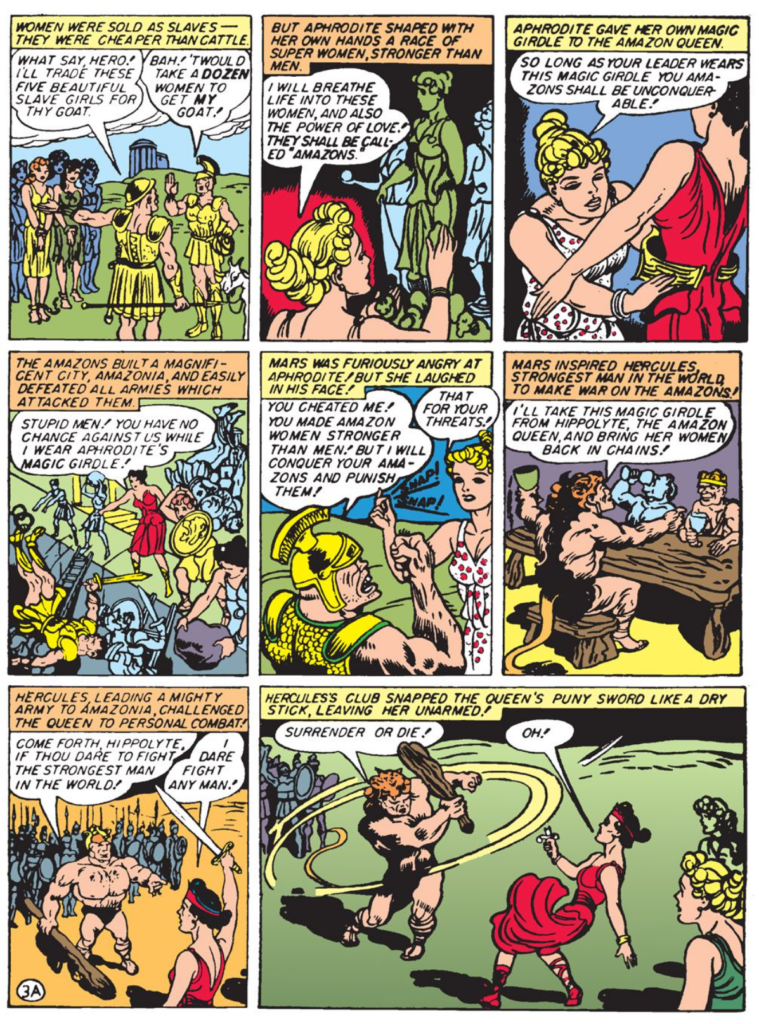
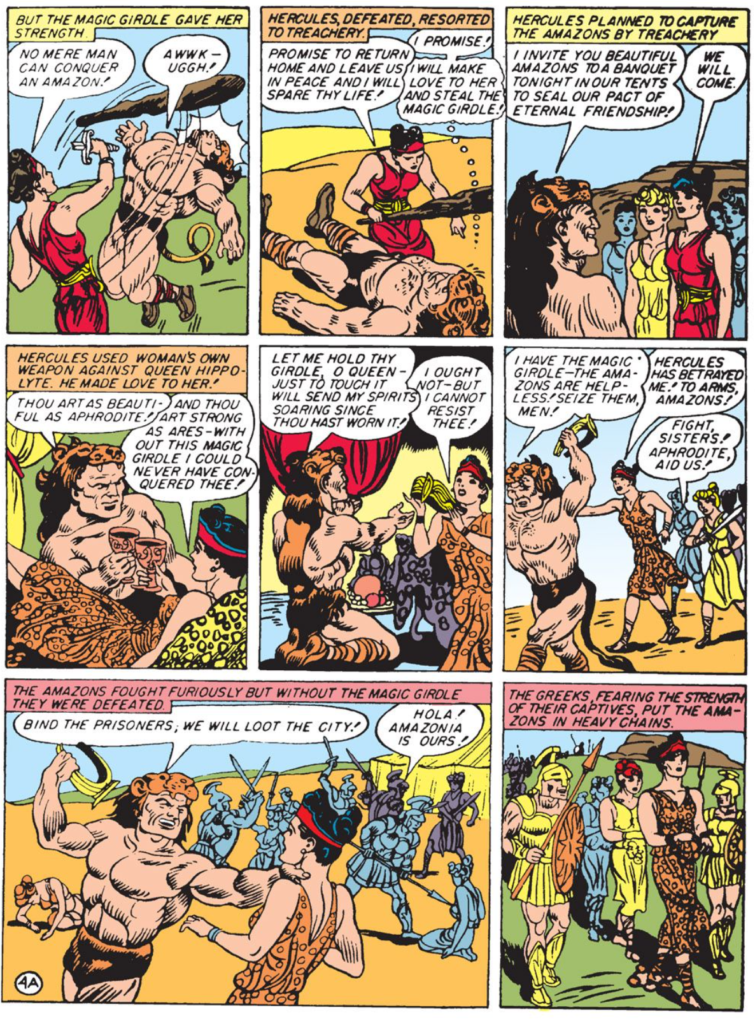
Decline of Super Hero Comics
After World War II super hero comics felt trite. Nearly all ceased publication by 1949. The ones that remained were Batman, Superman and Wonder Woman.